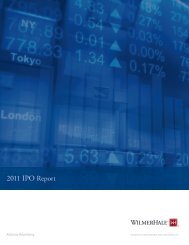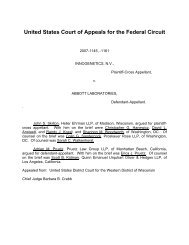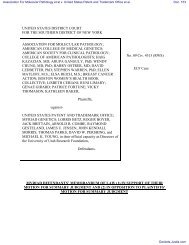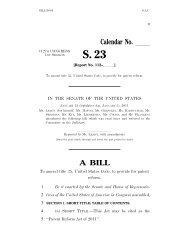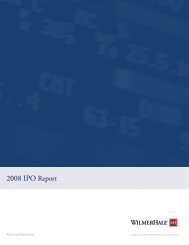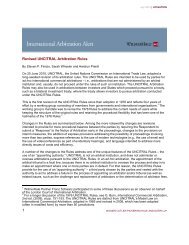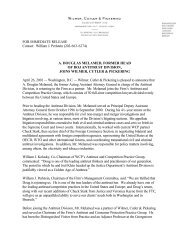2009 IPO Report - WilmerHale
2009 IPO Report - WilmerHale
2009 IPO Report - WilmerHale
- No tags were found...
Create successful ePaper yourself
Turn your PDF publications into a flip-book with our unique Google optimized e-Paper software.
<strong>2009</strong> <strong>IPO</strong> <strong>Report</strong>Attorney Advertising
Table of Contents26810121416US <strong>IPO</strong> Market Review and OutlookLaw Firm and Underwriter RankingsSelected <strong>WilmerHale</strong> Public OfferingsRegional <strong>IPO</strong> Market Review and Outlook– California– Mid-Atlantic– New England– Tri-StateTakeover Defenses in <strong>IPO</strong> CompaniesPIPE and Rule 144A Market Review and OutlookInitial Public Offerings: A Practical Guide to Going Public
2 US <strong>IPO</strong> Market Review and Outlook2008 ReviewUS <strong>IPO</strong>s – 1996 to 2008Facing the combined burden of aneconomic recession and plunging capitalmarkets, the <strong>IPO</strong> market turned inits worst performance in a generation.In 2008, there were only 31 <strong>IPO</strong>s—thelowest annual total since 1975—withgross proceeds of $24.1 billion (of which$17.9 billion came from a single offering).The year’s tallies were down 85% in dealvolume and 48% in gross proceeds from2007, ending a run of four strong yearsthat had averaged about 200 <strong>IPO</strong>s annually.US issuers86698768619975221996 1997Foreign issuers53757353 480433101998 1999446107339200091 75 7114 9 1077 1466 9 61 102001 2002 2003205 190 198 20734 32 35 58171 158 163 1492004 2005 2006 2007319222008While 2008 was a down year acrossthe board, the second half of the year waseven slower than the first. The <strong>IPO</strong> marketvirtually dried up in the second half of theyear, producing a mere six offerings raisingjust $1.0 billion. As discussed furtherbelow, the market drought continued into<strong>2009</strong>, before beginning to show signs ofrecovery in the second quarter.Source: SEC filingsEconomic conditions soured throughout2008 in the face of ongoing turmoil inthe credit markets, the continuing declinein the housing market and a stiff dropin consumer confidence—and the capitalmarkets followed suit. The Dow JonesIndustrial Average experienced thethird-worst year in its history, droppingby 34%, and the Nasdaq Compositedeclined by 41%.Every segment of the <strong>IPO</strong> market sufferedin 2008. The number of offerings byUS-based issuers fell from 149 in 2007 to22 in 2008, the number of <strong>IPO</strong>s by foreignbasedissuers decreased from 58 to 9,and the number of offerings by technologyrelatedcompanies declined from 107 to 9.<strong>IPO</strong>s by venture capital and privateequity backers dropped precipitouslyin 2008. The number of <strong>IPO</strong>s by USVC-backed companies plummeted from76 to 7—the lowest annual count inmemory. Similarly, the number of USbuyout-backed <strong>IPO</strong>s fell from 46 to 7.Among the year’s few bright spots wasVisa’s mammoth $17.9 billion <strong>IPO</strong>—thelargest US-issuer <strong>IPO</strong> in history. Otherlarge <strong>IPO</strong>s in 2008 came from AmericanWater Works ($1.25 billion), IntrepidPotash ($960 million) and GT Solar ($500million). Safe Bulkers produced the largestUS <strong>IPO</strong> Dollar Volume – 1996 to 200848.810.038.81996US issuers Foreign issuers $ billions59.728.98.730.8 32.11997Source: SEC filings40.8199895.333.761.61999108.252.755.5200041.3foreign-based-issuer <strong>IPO</strong> of 2008, withgross proceeds of $190 million, althoughits price declined 65% for the year.Despite gaining 10% on its first tradingday, the average 2008 <strong>IPO</strong> ended the year36% below its offering price. In 2007,the average <strong>IPO</strong> appreciated 15% by theend of the year. Only 16% of 2008 <strong>IPO</strong>swere trading at or above their offeringprice at year-end, compared to 55% in2007. The best-performing <strong>IPO</strong>s of 2008were Grand Canyon Education (up 57%),CardioNet (up 37%) and Visa (up 19%).9.132.2200125.46.419.0200215.26.19.1200346.539.0 31.440.415.38.7 5.2 10.930.326.229.4 31.32004200520062007Two 2008 <strong>IPO</strong>s more than doubled inprice on their opening days—Asia Time(up 143%) and Hong Kong HighpowerTechnology (up 110%)—but both endedthe year below their offering prices.The percentage of profitable companiesgoing public increased from 62% in2007 to 71% in 2008, while the medianannual revenue of <strong>IPO</strong> companiesincreased from $87.0 million to $113.5million. Both metrics evidenced the highstandards demanded of <strong>IPO</strong>s in 2008.In 2008, 9 <strong>IPO</strong>s (29% of the total)were completed by companies based in24.10.823.3 0.82008
US <strong>IPO</strong> Market Review and Outlook3the eastern United States (east of theMississippi River), western US–basedissuers accounted for 13 <strong>IPO</strong>s (42% of thetotal), and foreign issuers accounted forthe remaining 9 <strong>IPO</strong>s (29% of the total).Eastern US <strong>IPO</strong>s raised $2.8 billion ingross proceeds (12% of the total), westernUS <strong>IPO</strong>s raised $20.5 billion (85%), andforeign-issuer <strong>IPO</strong>s raised $0.8 billion(3%) of the year’s <strong>IPO</strong> proceeds.Percentage of Profitable <strong>IPO</strong> Companies – 1998 to 2008%5626 265261655962646271California maintained its position atopthe <strong>IPO</strong> state rankings with five <strong>IPO</strong>s,followed by Texas with four. China ledamong foreign-based issuers, with five<strong>IPO</strong>s, followed by England with two.19981999Source: <strong>IPO</strong> Vital Signs200020012002200320042005200620072008The percentage of <strong>IPO</strong> companies listingon Nasdaq—the preferred listing choicefor many venture-backed and technologycompanies—decreased from 62% in2007 to 39% in 2008, while the NYSE’smarket share increased from 36% to 55%.Surprisingly, and probably due to the smallsample size, the average <strong>IPO</strong> offering sizewas larger for companies listing on Nasdaq($111.7 million) than for companieslisting on the NYSE ($78.6 million).<strong>2009</strong> OutlookIn broad terms, the US <strong>IPO</strong> markethas gone through five phases overthe past two decades or so:■1991 to 1998—Reasonably stablemarket, producing an averageof more than 550 <strong>IPO</strong>s per year■1999 and 2000—Go-go marketcharacterized by many unqualified<strong>IPO</strong> companies and rampant priceeuphoria (although annual dealvolume was about 15% lower thanin the preceding eight years)■2001 to mid-2003—Very selectivemarket, in which deal volumes fellsubstantially and <strong>IPO</strong> candidateswere held to much higher standards■Mid-2003 through 2007—Solidmarket recovery, although notapproaching the deal volumes thatprevailed for most of the 1990s■2008—Market hits historic lowsBy historical measures, the year 2008 wasan anomaly for the <strong>IPO</strong> market. In the firsthalf of <strong>2009</strong>, however, the <strong>IPO</strong> outlookMedian Annual Revenue of <strong>IPO</strong> Companies – 1998 to 2008$ millions35.0199817.9 17.61999Source: <strong>IPO</strong> Vital Signs2000161.02001267.52002began to brighten amid a modest reboundin the capital markets and some signsthat the recession was beginning to abate.After only one <strong>IPO</strong> in the first quarterof the year, ten companies went publicin the second quarter of <strong>2009</strong>—nineof these priced at or above the top of theirranges, and all but one of the ten wastrading above its offering price at mid-year.On a hopeful note for the beleagueredventure capital and private equityindustries, six of the <strong>IPO</strong>s in the secondquarter were by VC-backed companies,and another one was buyout-backed.144.5200385.72004105.9 111.12005200687.02007113.52008We remain fundamentally optimisticabout the long-term prospects forthe <strong>IPO</strong> market. The exact pace of themarket recovery, however, is impossibleto predict. Important factors include:■Economic Conditions: Economic growthis a key determinant of strength in thecapital markets. By late 2007, five yearsof economic expansion—largely drivenby strong consumer spending andboosted by low interest rates, tax cutsand increased borrowing against homeequity as housing values soared—hadsputtered to an end. The followingrecession has been longer and more
4 US <strong>IPO</strong> Market Review and Outlooksevere than almost anyone anticipated.At mid-year <strong>2009</strong>, there are some signs ofrecovery, but the timing and extent of thereturn of economic growth is uncertain.■Capital Market Conditions: Stableand robust capital markets are a leadingindicator of <strong>IPO</strong> activity. After sharplydeclining in 2008, the Nasdaq stabilizedin the first quarter of <strong>2009</strong> and thenincreased by 20% in the second quarter.The Dow dropped another 13% inthe first quarter, before adding 11%in the second quarter, to approachbreakeven for the year to date. Mostobservers consider the markets’ prognosisfor the balance of the year to be mixed.■Impact of Regulatory Environment:Corporate governance reforms inthe United States have created newresponsibilities for public companiesand their directors and officers.These changes have helped improveaccountability to stockholders, boardoversight of management, board memberqualifications and investor confidence—but have also increased the cost ofbeing public, both in terms of potentialliability and the expense of compliance.The more rigorous corporategovernance environment may detersome <strong>IPO</strong> candidates, steer themto liquidity through acquisitions, incentthem to pursue <strong>IPO</strong>s in markets outsideof the United States, or cause themto pursue more unusual capital-raisingtransactions. There is some evidenceto support each of these suppositions.For most companies, however, thesecorporate governance changes can beassimilated into <strong>IPO</strong> planning and shouldnot pose a major impediment to goingpublic. The choppiness of the <strong>IPO</strong> marketfor much of this decade has far moreto do with economic and capital marketconditions than regulatory changes.■Venture Capital Pipeline: Venturecapitalists depend on <strong>IPO</strong>s—along withcompany sales—to provide liquidityto their investors. Only 13 VC-backedcompanies were in <strong>IPO</strong> registrationat mid-year <strong>2009</strong>, according to Dow JonesVentureOne. With the uptick in <strong>IPO</strong>sby venture capital–backed companiesin the second quarter of <strong>2009</strong>, thenumber of such companies enteringMedian <strong>IPO</strong> Offering Size – 1996 to 2008$ millions30.0199621615.0199633.01997Source: SEC filings12013.0199736.0199822.4681998Source: Dow Jones VentureOne25261.01999Venture Capital–Backed <strong>IPO</strong>s – 1996 to 200831.31999<strong>IPO</strong> registration, or resuscitatingdormant filings, is likely to increaseover the balance of the year.46.9 47.8 49.0Longer term, the pool of <strong>IPO</strong> candidateswill be affected by current trends inventure capital investing, includingthe timeline from initial funding to <strong>IPO</strong>.According to Dow Jones VentureOne,the median time from initial equityfinancing to <strong>IPO</strong> increased from 7.2 yearsin 2007 to 8.3 years in 2008—lengtheningthe period of time during which VCbackedcompanies must be privatelyfunded. As recently as 2004 and 2005,this figure hovered around 5.5 years.20184.020002000115.5 116.42001# of deals Median amount raised prior to <strong>IPO</strong> (in $ millions)22 18 23200120022002119.0200360.220036790.7200473.2200443102.6200552.02005■Private Equity Impact: Private equityinvestors also seek to divest portfoliocompanies or achieve liquidity through<strong>IPO</strong>s. PE-backed companies are usuallylarger and more seasoned than VC-backedcompanies or other start-ups pursuing<strong>IPO</strong>s, and thus can be strong candidatesin a demanding <strong>IPO</strong> market. Althoughlargely shut out of the 2008 <strong>IPO</strong> market,buyout-backed companies—especiallylarge and profitable ones—can beexpected to return to the <strong>IPO</strong> marketas conditions permit.
US <strong>IPO</strong> Market Review and Outlook5Profile of Successful <strong>IPO</strong> CandidatesWhat does it really take to go public?There is no single profile of a successful <strong>IPO</strong>company, but in general the most attractivecandidates have the following attributes:■Outstanding Management: An investmenttruism is that investors invest in people,and this is even more true for companiesgoing public. Every company goingpublic needs experienced and talentedmanagement with high integrity, avision for the future, lots of energy towithstand the rigors of the <strong>IPO</strong> process,and a proven ability to execute.■Market Differentiation: <strong>IPO</strong> candidates needa superior technology, product or servicein a large and growing market. Ideally, theyare viewed as market leaders. Appropriateintellectual property protection is expectedof technology companies, and in somesectors patents are de rigueur.■Substantial Revenues: With someexceptions, substantial revenues areexpected—at least $50 million to $75million annually—in order to providea platform for attractive levels ofprofitability and market capitalization.■Revenue Growth: Consistent and strongrevenue growth—25% or more annually—is usually needed, unless the company hasother compelling features. The companyshould be able to anticipate continuedand predictable expansion to avoidthe market punishment that accompaniesrevenue and earnings surprises.■Profitability: Strong <strong>IPO</strong> candidatesoften have track records of earningsand a demonstrated ability to enhancemargins over time.How Do You Compare? Some Facts About the <strong>IPO</strong> MarketSet forth below are selected metrics about the <strong>IPO</strong> market, based on combined datafor all US <strong>IPO</strong>s in 2007 and 2008.Median offering sizeMedian annual revenue of <strong>IPO</strong> companies$120.5 million (13% below $50 millionand 8% above $500 million)$87 million (34% below $50 million and 13%above $500 million)Percentage of <strong>IPO</strong> companies that are profitable 62% in 2007 and 71% in 2008Aftermarket performanceState of incorporation of <strong>IPO</strong> companiesPercentage of <strong>IPO</strong>s including sellingstockholders, and median percentage of offeringrepresented by those sharesPercentage of <strong>IPO</strong>s including directed shareprograms, and median percentage of offeringrepresented by those sharesPercentage of <strong>IPO</strong> companies disclosingadoption of ESPPPercentage of <strong>IPO</strong> companies using a “Big 4”accounting firmForm of outside director compensation paid by<strong>IPO</strong> companiesStock exchange on which the company’scommon stock was listedMedian number of Form S-1 amendments(excluding exhibits-only amendments) filedbefore effectivenessMedian <strong>IPO</strong> expensesBy year-end, average <strong>IPO</strong> price increased15% in 2007 and decreased 36% in 2008Delaware—93%No other state over 1%Percentage of <strong>IPO</strong>s—51%Median percentage of offering—26%Percentage of <strong>IPO</strong>s—47%Median percentage of offering—5%28%77%Cash only—10%Equity only—3%Cash and equity—87%Nasdaq—65%NYSE—32%Amex—3%FiveMedian underwriting discount 7%Time elapsed from initial filing to effectivenessof the Form S-1Legal—$1,200,000Accounting—$810,000Total—$2,760,000Median—117 calendar days25th percentile—89 calendar days75th percentile—170 calendar days■Market Capitalization: The company’spotential market capitalization shouldbe at least $200 million to $250 million,in order to facilitate development of aliquid trading market. If a large portionof the company will be owned by insidersfollowing the <strong>IPO</strong>, a larger market cap maybe needed to provide ample float.All <strong>IPO</strong> companies need top executive talent,a strong competitive position, adequate marketcapitalization and deal-savvy advisors, butother factors can vary based on a company’sindustry and size. For example, many biotechcompanies will have much smaller revenuesand not be profitable. More mature companiesare likely to have greater revenues and marketcaps, but slower growth rates. High-growthcompanies are likely to be smaller, and usuallyhave a shorter history of profitability.Beyond these objective measures, <strong>IPO</strong>candidates need to be ready for publicownership in a range of other areas, includingemployee recruitment and retention; accountingpreparation; corporate governance; financialand disclosure controls and procedures;external communications; and a varietyof corporate housekeeping tasks.
6 Law Firm and Underwriter RankingsEastern US <strong>IPO</strong>s – 1996 to 2008Counsel to the IssuerCounsel to the UnderwritersWilmer Cutler Pickering Hale and Dorr LLP8686172Skadden, Arps, Slate, Meagher & Flom LLP5164115Cravath, Swaine & Moore LLP157994Davis Polk & WardwellTesta, Hurwitz & Thibeault, LLP10 82 9225 66 91Latham & Watkins LLP285381Shearman & Sterling LLP165773Dewey & LeBoeuf LLP195372Simpson Thacher & Bartlett LLP313768Ropes & Gray LLP135063Morgan, Lewis & Bockius LLP431457Brobeck, Phleger & Harrison LLP233356Goodwin Procter LLP351651Sidley Austin LLP114051Sullivan & Cromwell LLP74249Source: SEC filingsEastern US Technology Company <strong>IPO</strong>s – 2004 to 2008Counsel to the IssuerCounsel to the UnderwritersWilmer Cutler Pickering Hale and Dorr LLP201333Ropes & Gray LLP41216Goodwin Procter LLP13215Cravath, Swaine & Moore LLP11213Latham & Watkins LLP5813Davis Polk & Wardwell1212Wilson Sonsini Goodrich & Rosati, P.C.Dewey & LeBoeuf LLP3 9 1211 11Shearman & Sterling LLP3710Skadden, Arps, Slate, Meagher & Flom LLP3710Mintz, Levin, Cohn, Ferris, Glovsky and Popeo, P.C.437DLA Piper US LLP336Hogan & Hartson LLP516Morgan, Lewis & Bockius LLP415Morrison & Foerster LLP235Pepper Hamilton LLP055Source: SEC filingsThe above charts are based on companies located east of the Mississippi River.
Law Firm and Underwriter Rankings7Issuer Counsel in US <strong>IPO</strong>s – 1996 to 2008Wilson Sonsini Goodrich & Rosati, P.C.214Cooley Godward Kronish LLP132Brobeck, Phleger & Harrison LLPWilmer Cutler Pickering Hale and Dorr LLP9195Latham & Watkins LLPHeller Ehrman LLPSkadden, Arps, Slate, Meagher & Flom LLPDLA Piper US LLPVinson & Elkins L.L.P.7471706763Morgan, Lewis & Bockius LLPKirkland & Ellis LLPFenwick & West LLPPillsbury Winthrop Shaw Pittman LLPGunderson Dettmer Stough Villeneuve Franklin & Hachigian, LLPGoodwin Procter LLP534946424138Source: SEC filingsBookrunner in US <strong>IPO</strong>s – 1996 to 2008Banc of America Securities LLC560Credit Suisse399J.P. Morgan365Goldman, Sachs & Co.341Morgan Stanley302Citi271Barclays Capital233Deutsche Bank SecuritiesUBS Investment Bank184201Friedman Billings Ramsey81Wells Fargo Securities, LLCCowen and CompanyPrudential SecuritiesPiper JaffrayCIBC World Markets6564575452Source: Thomson Reuters
Counsel of Choice fSERVING INDUSTRY LEADERS IN TECHNOLOGY, LIFE SCIENCES, CLEPublic Offerings ofCommon Stock and Senior Notes$6,750,000,000Counsel to IssuerPublic Offering of5.00% Notes Due July 1, 2014$375,000,000Counsel to IssuerInitial Public Offering ofCommon Stock$122,667,000Counsel to IssuerPublic OCommo$87,00CounselMarch and May <strong>2009</strong>June <strong>2009</strong>July <strong>2009</strong>AprilInitial Public Offering ofCommon Stock$58,100,000Counsel to IssuerPublic Offering of5.625% Senior Notes due 2019$500,000,000Counsel to IssuerInitial Public Offering ofCommon Stock$250,000,000Counsel to IssuerRule 144A Placement of1¼% Convertible Subordinated Notesdue 2010 and 1½% ConvertibleSubordinated Notes due 2012$200,000,000Counsel to IssuerJuly 2007August <strong>2009</strong>October 2007March 2007Public Offering ofCommon Stock$99,875,000Counsel to IssuerPublic Offering ofCommon Stock$81,242,000Counsel to UnderwritersPublic Offering of8.125% Notes Due 2019$1,000,000,000Counsel to UnderwritersPublic OCommo$44,00CounselJuly 2007August <strong>2009</strong>June <strong>2009</strong>NovembInitial Public Offering ofCommon Stock$135,204,000Counsel to IssuerJune 2007Public Offering ofCommon Stock$31,000,000Counsel to IssuerApril <strong>2009</strong>Initial Public Offering ofCommon Stock$61,600,000Counsel to UnderwritersAugust 2007
or Public OfferingsANTECH, FINANCIAL SERVICES, COMMUNICATIONS AND BEYONDffering ofn Stock0,000to IssuerRule 144A Placement of11% Senior Secured Second Lien Notesdue 2014$180,000,000Counsel to IssuerPublic Offering of4.50% Convertible Senior Notesdue 2014$190,000,000Counsel to IssuerRights Offering of ADRsRepresenting Ordinary Shares$1,037,000,000US Counsel to Issuer2008July <strong>2009</strong>April <strong>2009</strong>August <strong>2009</strong>Initial Public Offering ofCommon Stock$100,000,000Counsel to IssuerInitial Public Offering ofCommon Stock$41,616,000Counsel to IssuerInitial Public Offering ofCommon Stock$124,200,000Counsel to IssuerInitial Public Offering ofDebt Securities$600,000,000Counsel to IssuerApril 2007November 2007July 2007October 2008BIODELffering ofn Stock0,000to IssuerPublic Offering ofCommon Stock$45,517,000Counsel to Placement AgentRule 144A Placement of2.50% Convertible Senior Notes due 2014$125,000,000Counsel to IssuerPublic Offering ofCommon Stock$47,195,000Counsel to Issuerer 2007February <strong>2009</strong>June 2007February 2008Public Offerings ofSenior Notes$2,000,000,000Counsel to IssuerJanuary and March <strong>2009</strong>Initial Public Offering ofCommon Stock$115,115,000Counsel to UnderwritersMay 2007Public Offering ofCommon Stock$463,641,000Counsel to IssuerMay <strong>2009</strong>
10 Regional <strong>IPO</strong> Market Review and OutlookCaliforniaCalifornia <strong>IPO</strong>s – 1996 to 2008California produced only five <strong>IPO</strong>s in2008, compared to 43 in 2007, but grossproceeds soared from $5.73 billion to$18.21 billion because of Visa’s recordsized<strong>IPO</strong> in 2008. Without Visa’s $17.9billion <strong>IPO</strong>, however, proceeds fromCalifornia <strong>IPO</strong>s would have plummeted by94%. These results reflect the lowest levelof <strong>IPO</strong> activity in California in decades,mirroring national trends in 2008.# of deals1801066.844.51$ billions17.57169663.42131 12.9025 2.1515 1.56 181.376.275425 2.894.27355.7343518.21In addition to Visa, the other California<strong>IPO</strong>s of 2008 were from healthcarecompanies CardioNet ($81.0 million)and IPC The Hospitalist Company($83.2 million); security and compliancemanagement solutions provider ArcSight($61.8 million); and energy recovery devicemaker Energy Recovery ($119.0 million).1996 1997Source: SEC filings19981999200020012002200320042005200620072008The average California <strong>IPO</strong> in 2008ended the year 8% above its offeringprice—boosted by strong aftermarketperformances by CardioNet and Visa—compared to the 36% average declineexperienced by all <strong>IPO</strong>s nationwide.The California <strong>IPO</strong> market historicallyhas been dominated by technologyrelatedcompanies, with tech <strong>IPO</strong>sroutinely accounting for 80% to 90%of the total number of the state’s offerings.This trend is likely to resume as <strong>IPO</strong>activity returns to more normal levels.With capital market conditions improvingand signs of economic recovery appearing,we expect that California <strong>IPO</strong> activity willpick up in <strong>2009</strong>. The second quarter of thisyear saw successful <strong>IPO</strong>s by BridgepointEducation ($98.2 million) and OpenTable($60.0 million). Additional emergingcompanies that demonstrate strong growthin revenue and profitability can alsobe expected to come to market this year.Mid-AtlanticThe mid-Atlantic region of Virginia,Maryland, North Carolina, Delawareand the District of Columbia producedjust a single <strong>IPO</strong> in 2008, comparedto 10 in 2007. Gross proceeds dippedfrom $1.25 billion to $0.34 billion.Mid-Atlantic <strong>IPO</strong>s – 1996 to 200845# of deals1.561996463.361997Source: SEC filings$ billions2.4022199826 2.631999The region’s sole <strong>IPO</strong> of 2008 was the$337.5 million offering of Colfax, asupplier of fluid handling products. Pricedat $18.00 per share in May, the stockwas pulled down 42% by year-end, onlymodestly worse than the overall declinein capital markets over this period.Technology-related companies historicallyhave contributed a significant portionof the mid-Atlantic region’s <strong>IPO</strong> deal flow.We expect this pattern to resume withimprovements in the <strong>IPO</strong> market in <strong>2009</strong>.243.82200052.752001720020.96 0.9342003114.282004152.95200513 1.34 1.251020062007Rosetta Stone, a provider of technologybasedlanguage learning solutions,completed a $52.3 million <strong>IPO</strong> in April<strong>2009</strong>, and its stock appreciated 52%by the end of the second quarter.As conditions permit, the region’s <strong>IPO</strong>candidates in the balance of the yearshould include information technologyand life sciences companies, as wellas software and wireless companies.10.342008
Regional <strong>IPO</strong> Market Review and Outlook11New EnglandNew England <strong>IPO</strong>s – 1996 to 2008New England suffered a precipitous dropin <strong>IPO</strong>s in 2008. The region generated justone <strong>IPO</strong>, with proceeds of $0.5 billion, in2008, after producing 23 <strong>IPO</strong>s with $3.03billion in gross proceeds in the prior year.These figures represent the region’s lowestannual <strong>IPO</strong> proceeds since 2003, and thesmallest number of deals in many years.Even in a year with historically low levelsof <strong>IPO</strong> activity throughout the country,New England’s performance in 2008 wassurprising. In the last market trough of2001–2003, the region produced an annualaverage of four <strong>IPO</strong>s. And in the giddy daysof 1996–2000, New England was hometo an annual average of 44 offerings.# of deals793.63342.591996 1997Source: SEC filings$ billions463.64220.871998 19998.044120001.02320015.4695 4 0.40 0.532002 2003 2004162.7620051.991320063.0323200710.502008In 2008, the region’s only <strong>IPO</strong> camefrom New Hampshire–based GT Solar,a provider of specialized manufacturingequipment and services essential forthe production of photovoltaic wafers,cells and modules, and polysilicon. GTSolar’s <strong>IPO</strong> was unusual in that itconsisted entirely of shares sold byits controlling stockholder.Tri-State <strong>IPO</strong>s – 1996 to 2008# of deals $ billionsLogMeIn, a provider of on-demand,remote-connectivity solutions, raised$106.7 million in a late June <strong>2009</strong> <strong>IPO</strong>,and its stock immediately appreciatedby 25%. We expect New England’s <strong>IPO</strong>candidates in the remainder of <strong>2009</strong>to be drawn primarily from the technologysectors that have been the region’s areasof strength for decades.Longer term, we expect that continuedstrong levels of venture capital investmentin New England, along with the region’sworld-renowned universities and researchinstitutions, will continue to providea fertile environment for new companiesand <strong>IPO</strong> candidates.Tri-StateThe number of <strong>IPO</strong>s in the tri-stateregion of New York, New Jersey andPennsylvania declined from 17 in 2007to 3 in 2008. Gross proceeds followeda similar course, dropping from $8.08billion to $1.68 billion. Average deal sizein the region increased again, from $475.3million in 2007 to $560.3 million in 2008.1328.251996845.731997Source: SEC filings459.53199814.755.439.35The region’s <strong>IPO</strong>s in 2008 were byAmerican Water Works ($1.25 billion),a water and wastewater utility company;RHI Entertainment ($189.0 million),a developer, producer and distributor oftelevision programming; and RiskMetricsGroup ($245.0 million), a provider of riskmanagement and corporate governanceproducts and services. All three <strong>IPO</strong>sdeclined in the aftermarket. At yearend,American Water Works was trading3% below its offering price, followedby RiskMetrics Group (down 15%)and RHI Entertainment (down 42%).89199932200014 1320017.07200240.6120032920045.37 5.17252005Venture capital activity in the tri-stateregion now trails only that of Californiaand New England. VC-backed MedidataSolutions, a provider of hosted clinicaldevelopment solutions, completedan $88.2 million <strong>IPO</strong> in June <strong>2009</strong>, andits stock increased 17% by the end of thesecond quarter. We expect that otherVC-backed companies—including thosefrom the technology and life sciencessectors—as well as spinoffs from theregion’s established companies, will be <strong>IPO</strong>candidates in the balance of the year.
12Takeover Defenses in <strong>IPO</strong> CompaniesDuring the past several years,either in response to pressure fromstockholders or on their own initiative,the boards of many established publiccompanies have dismantled a numberof the anti-takeover provisions thatpreviously were considered standard.<strong>IPO</strong> companies, however, continueto implement anti-takeoverprovisions despite their decliningpopularity among established publiccompanies, primarily because:■the need for takeover defenses maybe greater given the <strong>IPO</strong> company’sstate of development, growth prospectsand market capitalization;■the existence of strong takeover defenseshas not historically had an adverseeffect on the marketing of <strong>IPO</strong>s; and■unless provisions required to beimplemented in the corporate charterare put in place prior to the <strong>IPO</strong>, itwill be virtually impossible to adoptthem after the company is public.The following is a summary of the mostcommon anti-takeover provisions adoptedby public companies, and some of thequestions to be considered by an <strong>IPO</strong>company’s board in evaluating them:Classified BoardsShould the entire board stand forre-election at each annual meeting,or should directors serve staggered threeyearterms, with only one-third of theboard standing for re-election each year?Opponents of classified boards believethat annual elections increase directoraccountability, which in turn improvesdirector performance, and that classifiedboards entrench directors and fosterinsularity. Supporters, however, believethat classified boards enhance theknowledge, experience and expertiseof boards by helping ensure that, at anygiven time, a majority of the directorswill have experience and familiaritywith the company’s business. Supportersalso believe classified boards promotecontinuity and stability, which in turnallow companies to focus on long-termstrategic planning, ultimately leading to abetter competitive positionand maximizing stockholder value.Limitation of Stockholders’Right to Remove DirectorsShould stockholders be able to removedirectors from office without cause?One consequence of a classified boardin a Delaware corporation, unless thecompany’s corporate charter providesotherwise, is that directors can onlybe removed by the stockholders for cause.When a classified board is eliminated, thedirectors can be removed with or withoutcause. Sometimes, the right to removedirectors is further limited by requiringa supermajority vote. Institutionalinvestors react particularly negativelyto provisions that require a supermajorityvote to remove a director for cause.Limitation of Stockholders’ Right toIncrease Board Size or Fill VacanciesShould stockholders have the right toincrease the size of the board and theright to fill vacancies, or should thoserights be reserved for the board?Activist investors believe that stockholders,as the ultimate owners of the company,should have a relatively unfettered abilityto change the composition of the boardand install directors they believe will bemore responsive to stockholder wishes.Supporters of limitations on these rightsbelieve that long-term value creationrequires stability and continuity in theboard, and that investors are appropriatelyprotected against entrenchment by thedirectors’ state law fiduciary duties,director independence requirements,and the stockholders’ ultimate abilityto elect replacement directors.Supermajority Voting RequirementsWhat stockholder vote should berequired to make changes to governanceprovisions or approve mergers: a simplemajority or a “supermajority”?Opponents of supermajority voterequirements believe that simple-majorityprovisions make the company moreaccountable to stockholders, leadingto better performance. In addition,opponents believe that supermajorityrequirements can be almost impossibleto satisfy because of abstentions andbroker non-votes, thereby frustratingthe will of the stockholders. Opponentsalso view supermajority requirementsas entrenchment provisions used toblock initiatives that are supported byholders of a majority of the company’sstock but opposed by management andthe board. Supporters, however, claimthat supermajority vote provisions helppreserve and maximize the value of thecompany for all stockholders by ensuringthat important protective provisions areeliminated only when it is the clear will ofthe stockholders. When companies havesupermajority provisions, the required votegenerally ranges between 60% and 80%.Prohibition of Stockholders’ Rightto Act by Written ConsentShould stockholders have the rightto act by written consent withoutholding a stockholders’ meeting?Almost all private companies make useof written consents as an efficient wayto obtain required stockholder approvalswithout the need for convening a formalmeeting. In contrast, most publiccompanies do not allow stockholders to actby written consent. They instead requirethat all stockholder action be taken at aduly called stockholders meeting, for whichstockholders have been provided detailedinformation about the matters to be votedon, and at which there is an opportunityto ask questions about proposed business.Limitation of Stockholders’ Rightto Call Special MeetingsShould stockholders have the right tocall special meetings, or should they berequired to wait until the next annualmeeting to present matters for action?Many public companies provide thatonly the board or specified officers ordirectors are authorized to call specialmeetings of stockholders. This couldhave the effect of delaying until the nextannual meeting actions that are favoredby holders of a majority of the company’sstock. Other companies allow stockholdersholding more than a specified threshold
Takeover Defenses in <strong>IPO</strong> Companies13of the outstanding shares—commonly10% to 40%—to call special meetings.Companies that allow stockholders tocall special meetings, however, oftenauthorize the board to set the preciselocation and date of such meetingsand sometimes preclude stockholdersfrom calling for a special meetingclose in time to an annual meeting.Advance Notice RequirementsShould stockholders be required tonotify the company in advance ofdirector nominations or other mattersthat the stockholders would like to actupon at a stockholders’ meeting?Advance notice requirements providethat stockholders at a meeting mayonly consider and act upon directornominations or other proposals thathave been properly brought before themeeting. In order to be properly brought,a nomination or proposal must bespecified in the notice of meeting andmust be brought before the meetingby or at the direction of the board, orby a stockholder who has deliveredtimely written notice to the company.These provisions could have the effectof delaying until the next stockholdermeeting actions that are favored by theholders of a majority of the company’sstock. Investors generally do not object toadvance notice requirements, so long asthe advance notice period is not undulylong. Advance notice periods of 90 to 120days prior to the anniversary of the prioryear’s annual meeting date are common.State Anti-Takeover LawsShould the company opt out of anystate anti-takeover laws to which itis subject, such as Section 203 of theDelaware corporation statute?Section 203 prevents a publicly heldDelaware corporation from engagingin a “business combination” with any“interested stockholder” for three yearsfollowing the time that the person becamean interested stockholder, unless, amongother exceptions, the interested stockholderattained such status with the approval ofthe board. A business combination includesa merger or consolidation involvingthe interested stockholder and the saleThe following table sets forth the percentages of all <strong>IPO</strong> companies in 2007 and 2008 that adopted specifiedtypes of takeover defenses prior to or in conjunction with going public:Takeover Defenseof more than 10% of the company’s assets.In general, an interested stockholder isany entity or person beneficially owning15% or more of the company’s stock andany entity or person affiliated with orcontrolling, or controlled by, such entityor person. A public company incorporatedin Delaware is automatically subjectto Section 203 unless it opts out in itsoriginal corporate charter or pursuantto a subsequent charter or bylawamendment approved by stockholders.Blank Check Preferred StockShould the board be authorizedto designate the terms of series ofpreferred stock without obtainingstockholder approval?When “blank check” preferred stockis authorized, the board has the rightto issue shares of preferred stock in oneor more series without stockholderapproval under state corporate law, andhas the discretion to determine the rightsand preferences of each such series ofpreferred stock. Authorizing the boardto issue preferred stock and determineits rights and preferences has the effectof eliminating delays associated witha stockholder vote on specific issuances.Having blank check preferred stock inplace often facilitates the adoption of astockholder rights plan, financings andthe negotiation of strategic alliances.The issuance of preferred stock, however,can be used as an anti-takeover device.Stockholder Rights PlansPercentage of<strong>IPO</strong> CompaniesClassified board 60%Supermajority voting requirements to approve mergers or changecorporate charter and bylawsProhibition of stockholders’ right to act by written consent 69%Limitation of stockholders’ ability to call special meetings 74%Advance notice provisions 80%Section 203 of the Delaware corporation statute (chose not to opt out) 90%Blank check preferred stock 76%Stockholder rights plan (“poison pill”) 6%53%Should the company establish a poison pill?A stockholder rights plan, often referredto as a “poison pill,” is a contractual rightthat allows all stockholders—other thana stockholder who acquires more thana specified percentage of the company’sstock—to purchase additional securitiesof the company at a specified price. Ifsomeone triggers the rights plan, thatperson’s economic and voting power willbe significantly diluted. Supporters believerights plans are an important planningand strategic device because they givethe board time to evaluate unsolicitedoffers and to consider alternatives, andcan deter abusive acquisition techniquessuch as partial offers and “two-tier”tender offers. Opponents view rightsplans, which can generally be adoptedby board action at any time and withoutstockholder approval, as an entrenchmentdevice and believe that rights plansimproperly give the board, rather thanstockholders, the power to decide whetherand on what terms the company is to besold. When combined with a classifiedboard, rights plans make an unfriendlytakeover particularly difficult.
14PIPE and Rule 144A Market Review and OutlookFollowing an <strong>IPO</strong>, a public companymay raise additional equity capitalthrough follow-on public offerings, orthrough private placements known as PIPEor Rule 144A placements. Activity in 2008for both types of private placementsreflected broader market trends—PIPEdeal volume dropped by one-third, butdollar volume and average deal size morethan doubled to record highs, while thenumber and dollar volume of Rule 144Aplacements fell to their lowest levels inat least seven years. The flexibility of PIPEand Rule 144A placements in uncertainmarket conditions should remainattractive to many companies in <strong>2009</strong>.PIPE Financings – 2001 to 2008# of deals $ in billions1,6411,2941,3261,05422.516.6 18.4 18.62001200220032004Includes closed deals only.Source: PrivateRaise1,584200523.01,874200638.71,978200771.11,3112008121.1PIPE FinancingsThe composition of the PIPE (PrivateInvestment in Public Equity) marketchanged significantly in 2008 inresponse to broader trends in the capitalmarkets. PIPE deal volume dropped by34% from 2007, but dollar volume andaverage deal size soared to record highsas beleaguered financial institutionssought large capital infusions.Rule 144A Equity Placements – 2001 to 2008# of deals $ in billions24672.967.316714135.477 25.38124.811049.212354.34815.4The number of PIPE deals (includingregistered direct offerings) droppedfrom a record 1,978 in 2007 to 1,311in 2008. Dollar volume, however, surgedfrom $71.7 billion to a new high of $121.1billion—nearly eight times the size of theRule 144A market. Multi-billion-dollarPIPE financings in the financial servicessector pushed average deal size to a record$92.4 million, two-and-a-half times theprior record of $36.2 million set in 2007.In 2008, there were 19 PIPE financingsthat raised more than $1 billion each,compared to 11 billion-dollar dealsin 2007. The largest PIPE financingin 2008 raised $12.5 billion, and the top10 deals—all by financial institutions—collectively raised more than $71 billion.Companies with market capitalizationsunder $250 million were responsiblefor 84% of all PIPE financings in 2008,down slightly from 85% in 2007, whilecompanies with market caps below$50 million accounted for 52% of allPIPEs—up from 49% in the prior year.2001Includes closed deals only.Source: PrivateRaise200220032004Healthcare was the most active PIPEsector in 2008, with 25% of all deals and anaverage deal size of $14.7 million, followedby technology (18% and $13.7 million)and energy (12% and $41.4 million).Financial services companies contributed12% of the year’s deals and a whopping76% of the gross proceeds, resulting inan average deal size of $672.9 million.Of all PIPE financings in 2008, 52%were common stock (average deal sizeof $50.7 million). The next-largestsegments were convertible debt (21% ofall PIPEs and $101.1 million average size)and convertible preferred stock (13%of all PIPEs and $319.8 million averagesize). This deal breakdown reflectsa shift from common stock deals toconvertible deals that offer more downsideprotection in uncertain conditions.Fixed-price deals represented 89% of allPIPE deals in 2008, up slightly from 88%20052006in 2007. The percentage of deals withvariable pricing was unchanged at 6%.The average discount from market infixed-price common stock PIPE deals was2% in 2008. The percentage of deals thatincluded warrants was 51%, the averagewarrant exercise premium was 36%, andthe average warrant coverage was 71%.Among fixed-price convertible debtPIPE deals in 2008, the average conversionpremium was 38%, the average term wasthree years, and the average interest ratewas 8.8%. Warrants were included in65% of the deals—the average warrantexercise premium was 21% and theaverage warrant coverage was 81%.Rule 144A Placements20072008The Rule 144A market for equity securities(including convertible debt) contractedsharply in 2008. The number of placements
PIPE and Rule 144A Market Review and Outlook15Company Counsel in Eastern US Rule 144A Equity Placements – 2001 to 2008# of deals Proceeds (in $ billions)Wilmer Cutler Pickering Hale and Dorr LLPSkadden, Arps, Slate, Meagher & Flom LLPSimpson, Thacher & Bartlett LLPLatham & Watkins LLPShearman & Sterling LLPHogan & Hartson LLPJones DayDavis Polk & WardwellJones, Walker, Waechter, Poitevent, Carrere & Denegre LLPSidley Austin LLPWeil, Gotshal & Manges LLPKramer Levin Naftalis & Frankel LLPMcDermott Will & Emery0.92.21.92.42.11.71.63.03.54.34.088877791010111110.3202111.7dropped 61% from 2007 and grossproceeds plummeted by 72%.The number of Rule 144A equityplacements decreased from 123 in 2007to 48 in 2008, while gross proceeds shrankfrom $54.3 billion to $15.4 billion. Averagedeal size also dropped, to $320.5 millionin 2008 from $441.7 million the yearbefore. The number of billion-dollarplacements plunged from 17 in 2007 totwo, as most very large equity placementsin 2008 were structured as PIPE deals.Rule 144A issuers tend to be much largerand more mature than issuers in the PIPEmarket (although, as discussed above, largefinancial institutions flocked to the PIPEmarket in 2008). Companies with marketcaps above $1 billion accounted for 69%of all Rule 144A placements in 2008, butonly 6% of all PIPE deals.The healthcare sector led the Rule 144Aequity market in 2008, with 19% of allThe above chart is based on companies located east of the Mississippi River.Source: PrivateRaisedeals and an average deal size of $296.6million, followed by energy (17% and$284.6 million) and financial services(13% and $314.2 million).In 2008, all but one Rule 144A equityplacement involved the issuance ofconvertible debt securities, essentiallyunchanged from 2007. SEC rules generallydo not permit public companies to offercommon stock in Rule 144A placements,and convertible preferred stock placementshave all but disappeared from the market.Among all Rule 144A convertible debtplacements in 2008, the average conversionpremium was 29%, the average term was11 years, and the average interest rate was4.3%. Warrants were included in only 7%of these placements.Seasoned public companies have longrecognized the faster execution time andgreater flexibility afforded by Rule 144Aplacements. The Rule 144A market declinein 2008 probably reflects overall capitalmarket conditions, as well as the decisionby large companies that qualify as“WKSIs” to structure convertible debtofferings as registered public offeringsrather than Rule 144A placements.
AnnouncingInitial Public Offerings: A Practical Guide to Going PublicDrawing on <strong>WilmerHale</strong>’s decades of <strong>IPO</strong> leadership, this book presentsa comprehensive yet practical guide to the going-public process.Preparation, planning and crisp execution have never been more vital to your chances of <strong>IPO</strong>success. Now there’s a guide that charts every twist and turn on the path to a winning <strong>IPO</strong>. Hailedby executives, entrepreneurs, general counsel, investment bankers, venture capitalists and accountantsalike as the first comprehensive <strong>IPO</strong> resource, Initial Public Offerings: A Practical Guide to Going Publicdemystifies the <strong>IPO</strong> process with real-world advice straight from the <strong>IPO</strong> trenches. Packed with practicalguidance, planning tips, best practices and empirical data, this readable guide will help you avoidroadblocks, frame smart questions and make better decisions on every step of the <strong>IPO</strong> journey.“CEOs should keep this book at their side from the moment they first seriously consideran <strong>IPO</strong>… and will soon find it dog-eared with sections that inspire clarity and confidence.”— Don Bulens, CEO of EqualLogic at the time it pursued a dual-track <strong>IPO</strong>“There’s nothing I like more than practical guidance. And this book sure fits the billas a detailed step-by-step guide that every practitioner should have. A perfect starter’s kit.”— Broc Romanek, Editor of TheCorporateCounsel.net“This book sets the standard against which any future <strong>IPO</strong> guide will be measured,and should be required reading for management and boards of any company contemplatinga public offering.”— David B. Elsbree, public company director and retired audit partner“This book demystifies the entire <strong>IPO</strong> process, from A to Z. It is incredibly easyto find what you are looking for and, most importantly, to quickly understand thesubject matter. Whether you are a C‐level executive, a seasoned practitioneror Joe the Plumber, you will benefit greatly from having so much pulled togetherin one organized spot.”— Greg Beecher, CFO, Teradyne“The most complete book about going public ever written—almost everythinga company’s management needs to know.”— Jay R. Ritter, Cordell Professor of Finance, University of FloridaHow to Order:The book will be published in October <strong>2009</strong> and may be purchased from the publisher at www.pli.eduor by calling (800) 260-4754. A 20% discount is available to <strong>WilmerHale</strong> clients and friendsby specifying the code KAD9-8WEB1.For more information, visit www.<strong>IPO</strong>guidebook.com.
Want to know moreabout the venture capitaland M&A markets?Our <strong>2009</strong> Venture Capital <strong>Report</strong> offers an in-depthanalysis of, and outlook for, the US and Europeanventure capital markets. The report featuresindustry and regional breakdowns, an analysisof the VC fund formation climate, a discussion ofstock option repricing in private companies, andan overview of trends in venture capital financingand VC-backed company M&A deal terms.See our <strong>2009</strong> M&A <strong>Report</strong> for a detailed reviewof, and outlook for, the global M&A market. In otherhighlights, we discuss the likely course of antitrustenforcement in the Obama administration and presenta survey of key terms in sales of VC-backed companies.To request a copy of any of the reports described above,or to obtain additional copies of the <strong>2009</strong> <strong>IPO</strong> <strong>Report</strong>,please contact the <strong>WilmerHale</strong> Marketing Departmentat marketing@wilmerhale.com or call +1 617 526 5600.An electronic copy of this report can be foundat www.wilmerhale.com/<strong>2009</strong><strong>IPO</strong>report.Data Sources<strong>WilmerHale</strong> compiled all data in this report unlessotherwise noted. Offerings by REITs, bank conversions,closed-end investment trusts and special purpose acquisitioncompanies are excluded. Offering proceeds excludeproceeds from exercise of underwriters’ over-allotmentoptions, if applicable. For law firm rankings, <strong>IPO</strong>s areincluded under the current name of each law firm. Venturecapital data is sourced from Dow Jones VentureOne.PIPE and Rule 144A data is sourced from PrivateRaise.© <strong>2009</strong> Wilmer Cutler Pickering Hale and Dorr llp
09_026 RPI 09/09 11,000<strong>WilmerHale</strong> recognizes its corporate responsibility to environmental stewardship.wilmerhale.comWilmer Cutler Pickering Hale and Dorr llp is a Delaware limited liability partnership. Our United Kingdom offices are operated under a separate Delaware limited liability partnership of solicitors and registered foreign lawyersregulated by the Solicitors’ Regulation Authority (SRA No. 287488). In Beijing, we are registered to operate as a Foreign Law Firm Representative Office. Wilmer Cutler Pickering Hale and Dorr llp principal law offices: 60 State Street,Boston, Massachusetts 02109, +1 617 526 6000; 1875 Pennsylvania Avenue, NW, Washington, DC 20006, +1 202 663 6000. This material is for general informational purposes only and does not represent our legal advice as to anyparticular set of facts; nor does it represent any undertaking to keep recipients advised of all relevant legal developments. Prior results do not guarantee a similar outcome. © 2004–<strong>2009</strong> Wilmer Cutler Pickering Hale and Dorr llp



